Upload Complete

In January, following a year of stalled growth and financial disappointment, Twitter shed nearly half of its core leadership. Three days later, Adam Bain, the company’s (surviving!) Chief Operating Officer, posted this complaint:
“Code for Twitter” https://t.co/pZdbJNx67J
— adam bain (@adambain) January 28, 2016
The linked tweet:
Wherein Facebook editorializes the Kanye Wiz ordeal as “a series of posts on social media.” 😂😂😂 pic.twitter.com/RVCZ5kE4fO
— Josh Williams (@jw) January 28, 2016
That day, Kanye West and Wiz Khalifa had gotten into a fight on Twitter, roping in Amber Rose and setting off a massive and spontaneous celebrity media event. The choice of medium was a notable and conspicuous part of the story: West’s Twitter presence is uneven but legendary; one of his posts (erroneously) mocked Khalifa for losing followers; he mentioned looking at Khalifa’s timeline. It’s where responses were expected to show up, and did.
An editor at Facebook, confronted with an unignorably viral disturbance that originated entirely outside the platform, wrote up the event for Facebook’s trending news service as “a series of posts on social media,” dropping a couple proper nouns, both of which start with the letter T. Bain, citing further examples of feed-washing from Facebook, joked: “Working on changing my business card to: COO of Social Media,” and linked to this tweet:
Facebook must have some sort of algorithm tweak that changes every instance of “twitter” to “social media” pic.twitter.com/nAm3aNMtts
— ಠ_ಠ (@MikeIsaac) January 28, 2016
Whether you think Twitter is dead or dying or misunderstood and undervalued, a competitor’s sidebar attribution practices seem like a petty thing for its COO to be focusing on right now. (“Hey… Facebook… ᔥ much? Yeah well ↬ you!!!”) But the complaint speaks to a set of real anxieties burbling underneath the various structures and businesses that make up the popular internet, and Twitter in particular. On a near-future internet broken into increasingly self-sufficient platforms, territory, borders and ownership will matter a great deal. Twitter has to stake its claim.
Back when Twitter made of point of calling itself the “global town square” at every possible opportunity, most noticeably as it was preparing to go public, the claim contained a grain of truth. Twitter was a place that allowed people to congregate on-platform in ways they wouldn’t have been able to before. It was a community unto itself, and a productive one. But it was also, largely, a place for people to talk about other stuff online. It was a public comment section for the web. Twitter’s growth years were about a lot of things: celebrities, activism, news. They were also about links. In 2012, Twitter was big. And important! But it was still just one part of the actual global town square, just one especially large and coherent website of many.
Even then, though, a major shift in online power was already well under way: from computers to phones; from sites to apps; from an intoxicatingly wild and decentralized mess (the web, websites, links, etc., managed by loose shared standards and accessed in browsers) to a few intoxicatingly huge managed populations (the platforms, managed by themselves and accessed in apps). In 2016, the still-vast and still-growing web is comparatively diminished. Slightly newer platforms, such as Instagram and Vine, hardly touch it; Snapchat doesn’t even acknowledge it. A now-ubiquitous Facebook, meanwhile, has gradually replaced, within its platform, parts of the web its users shared most: outside videos; outside articles; outside personal sites; outside listings; outside streams; soon, maybe, outside audio streams. Twitter, slowly and with less leverage, has been doing the same: a feed of text and links has become a feed of photos, videos, audio, and, next, posts over 140 characters. The platforms that came of age on the web are leaving it behind.

Most of the material clashes between Facebook and Twitter have been minor. Remember when Instagram images expanded automatically inside tweets? That was nice! It also amounted to the direct and constant promotion of a competing service, or, from Instagram’s perspective, the large-scale use of another service’s content. But such withdrawals, which occurred during a time when the companies’ feeds were becoming more visually and functionally alike, were insignificant in comparison to what the services still shared: an outside media fostered, divided and fueled by a vast and agnostic web. The services were distinct in many ways, but the manner in which they processed and displayed the same material was a significant one. Posts from the same sites. Videos from the same YouTube. A world of media laundered into feeds by links.
A feed, then, was a mixture of personal posts and pitches to look at other things. It was an endless stream of captions contextualizing a Great Big Outside. But each year the feeds got richer. The captions expanded into previews. The previews expanded into full photos, videos and posts. The remaining links underneath came to resemble vestigial metadata. This was easy to notice from the outside, from the perspective of, say, a publisher, for whom change was reflected in referrals and traffic. For users, the change happened gradually and subtly, over the course of a million consecutive pulls to refresh.
This tendency toward richer feeds was driven by the metrics with which platforms openly define success: engagement time, interactions, etc. Presented with the split-second option of viewing or sharing something fast and in-feed or slower and off-feed, users predictably prefer the former — the one that feels more like it was part of the app they were using.
And so the terms of inter-platform competition changed. Back in 2012 and 2013, a nascent territorialism played out quietly, through emails sent to reporters imploring them to cover Instagram’s presence at the Oscars, or the best tweets from Super Bowl. Platforms competed at a distance with a new feature here, a complimentary app there. But without a big wide web in the middle, the comparisons become stark and immediate, and more obvious to anyone who’s looking. So it makes a little bit of sense that Twitter would like you to know that, for all Facebook has, it didn’t have the Kanye fight. Instagram didn’t have it. Snapchat didn’t either. He chose them.

Facebook and Twitter first grew on the web but exploded on smartphones, their endless scrolling feeds positioned fortuitously for touchscreens. Snapchat, Instagram and Vine, which grew later, were designed first with phones in mind. On those services, activity is fueled exclusively by things people are typing, shooting or recording themselves. They owe very little to the web, in both senses of the word; likewise, no other party can claim much of a hand in their growth, except perhaps the mobile operating systems on which they run, or the companies that own them. The common material people consume and talk about on Instagram and Snapchat — its widely shared media — originates there.
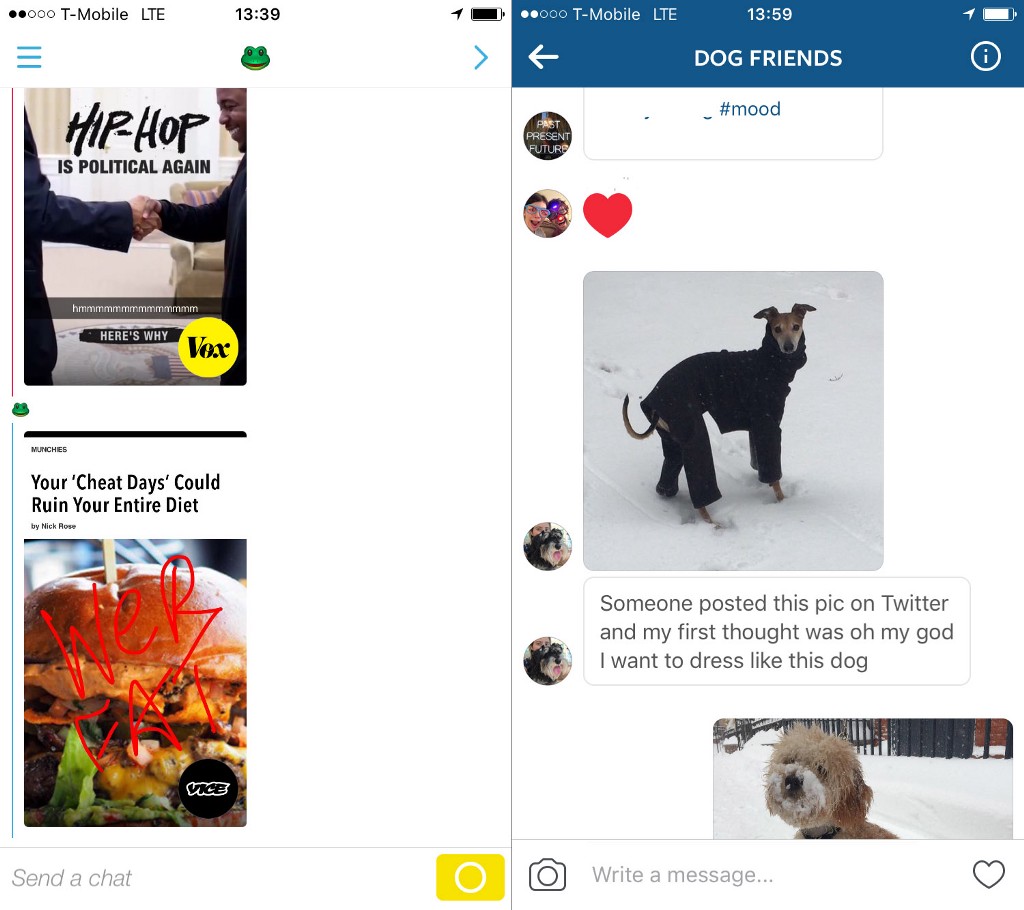
While the platforms born on the web are gradually replacing outside media with media created within their walls, the services born as apps are attempting to create, or foster the creation of, a professional media within theirs. In doing so, the largest platforms of both origins are developing interesting commonalities: Facebook hosts most media types, as does Twitter. Instagram captions are long enough for personal posts or news stories below its photos and videos, and its chat function provides a new context in which to share them. Snapchat, with Discover, is attempting to host a popular media in miniature, and recently added the ability to share it with other users.
Each platform, in other words, seems to be setting itself up for self-sustenance. But each faces a slightly different task. Snapchat wants to terraform itself from a communications app into a functioning and complex media ecosystem. Instagram has editors curating events and hashtags into media objects that users can’t make themselves. Facebook wants to broadly remake the internet to better serve four of the largest groups of users ever accumulated, eliminating the waste and redundancy produced by interaction with an unwieldy parallel infrastructure that it can’t control. Twitter is doing lots of things, but mostly wants to continue to exist, please. Thanks!

In early January, DJ Khaled, whose weird and wildly entertaining Snapchat presence has attracted millions of followers in a matter of months, visited Snapchat’s headquarters to meet with founder Evan Spiegel. Here is a photo of the meeting from Instagram.
A photo posted by DJ KHALED (@djkhaled) on Jan 12, 2016 at 4:37pm PST
This event was well-documented on Khaled’s Snapchat; I know this because I caught up on his posts through the various YouTube and Instagram accounts that archive and repost his posts constantly, accumulating hundreds of thousands of views on their own. Such videos are frequently captioned with copy-and-paste definitions of “fair use” or variations of the phrase “No Copyright Intended.”
A couple weeks after his visit to Snapchat HQ, Khaled anchored the official Snapchat Discover channel for Fusion, one of a small group of companies allowed to publish more than just snaps into the app. Here’s a sample day, again hosted on YouTube, which is owned by Google, which is one of a few companies that failed to buy Snapchat in 2013:
A lot of people watched this, probably. Publishers don’t talk too much about their Discover numbers; those who are given access to the limited metrics that Snapchat provides sign NDAs. Limited space and a constant fear of ejection keep Discover parters from talking too much amongst themselves, since they’re competing not just for audience but for the right to exist. But Discover, to the extent partners say anything about it, is reportedly big: Cosmo claims its channel is visited by three million people a day; late last year, BuzzFeed said Snapchat accounted for about a fifth of its monthly content views (roughly a billion).
But Khaled’s own account is almost certainly more popular than Fusion’s Discover page. He posted a screenshot of his stats in December:
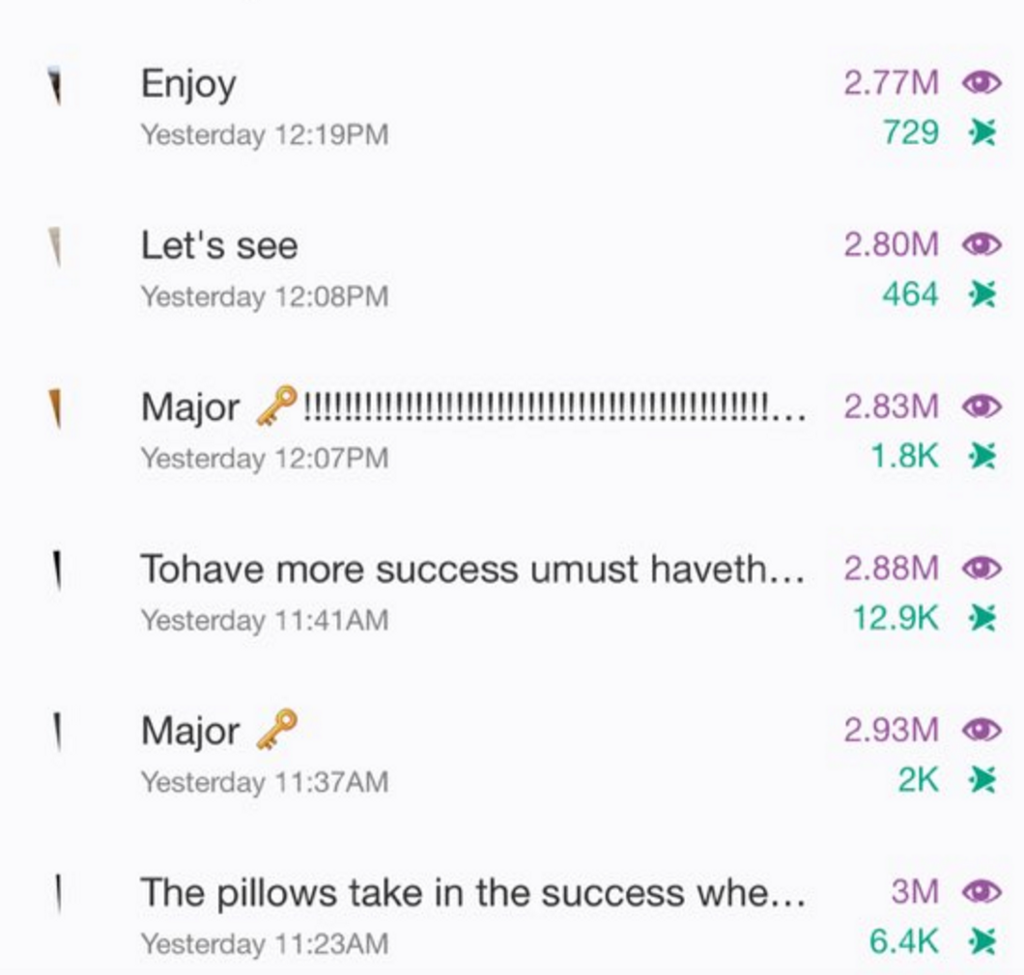
The ways this comparison is imperfect mostly favor Khaled. His views come from subscribers. Fusion’s, mostly, come from Discover browsers. He’s one famous person with a a little bit of help posting mostly videos of himself; they’re a staff of multiple people publishing media under an unfamiliar brand that was until recently backed by two separate old media conglomerates. In the end, maybe Fusion got some temporary exposure and goodwill. Khaled, at the very least, got some new followers.

When it first debuted, I understood Snapchat’s Discover as an awkward static attachment to a communications app. It kind of was! There was no easy way to share full stories–only screenshots–and there wasn’t much to share. But now there’s an official sharing function. Which… has been working to some extent, according to some partners? From a report in IBTimes:
For now, publishers are boasting about their Snapchat views as they follow the buzz around mobile and millennials. “On Thanksgiving, Cosmo’s Snapchat Discover channel ran videos of shirtless guys with pies. The videos generated 442,456 shares in one day,” Troy Young wrote in the end-of-year email for Hearst Magazines Digital Media.
Partners are both figuring out what works and figuring out what it is they’re supposed to be figuring out. Are they optimizing for shares now? Are they optimizing for views inside the Discover tab? They’re as much trying to understand what Snapchat wants out of them as they are what their users want, and the uncertainty shows. Here, from the Mashable channel, are a few recent examples of Discover posts:
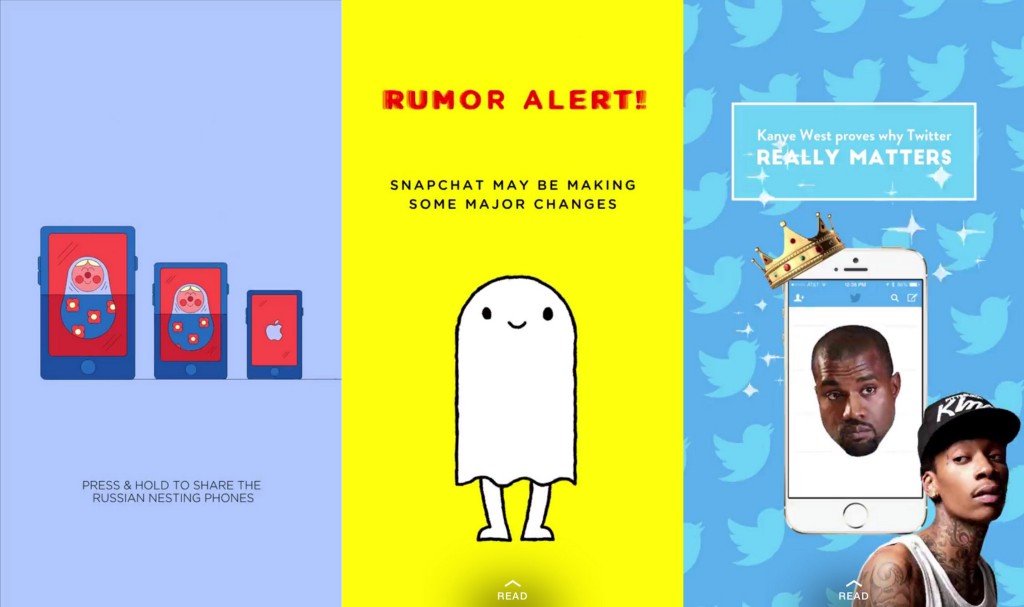
Does this actual call to share work on Snapchat? Maybe. How about this article about Snapchat? Worth a shot! Maybe a Twitter thinkpiece? It was already written anyway.
Watch Discover and you’ll see new little trends almost every week. Vox launched with a novel strategy for its channel, parceling out a single story presented over a number of slides (HELL-TREND HELL-PIECE: SNAPCHAT, TWITTER MOMENTS AND THE TRIUMPHANT RETURN OF THE SLIDESHOW). Cosmopolitan’s channel is held up as a success, but it’s more of a grab bag of jokes and lists and polls and videos than a coherent single object. The Vox slideshow is a smart use of space, perhaps better suited to viewing than sharing. BuzzFeed’s, which is full of “share ifs” and animations, seems focused much more on the latter. In any case, their relative successes are a matter of gossip and conspiracy and magic and supposition — for everyone except Snapchat.
Discover partners are given the impression, by Snapchat and by the limited metrics Snapchat shows them, that they’ve been granted special access to a huge resource — exclusive contracts to mine untold reserves of particularly valuable human teen attention. In the core Snapchat product, advertising feels intrusive. Discover creates a controlled space around advertising, and diverts some of its hundreds of millions of users to see it. Snapchat has accumulated an abundance of people and attention; Snapchat has a monopoly over advertising to its users; Snapchat devised, in addition to selling ads against its own Stories, an advertising product that doesn’t interfere with its service; Snapchat needed something against which to sell those ads; Snapchat used its audience, which exists only on Snapchat, to convince partners to fill its fresh expensive void.
It’s fascinating! And poses so many questions. For example: If partners remain limited, sort of like TV networks, will they make enough compelling stuff not to become The Boring Tab? If partners are expanded, does their share of audience remain large and lucrative enough to justify the full time staffers that run these channels? Does it become a huge marketplace like YouTube, attracting unexpected new talent who will create unexpected new forms? If Discover content becomes something primarily consumed by Snapchatters due to sharing of individual items, not views within the slideshow-style channels with obvious places to put ads, then where do the ads end up? Wasn’t that the whole point? And where does Snapchat’s participation start and stop? Snapchat had a channel, then closed it, and now has political reporter Pete Hamby anchoring politics coverage that appears on users’ homescreens whenever and wherever Snapchat pleases.
In contrast to the advertising-oriented, awkwardly placed Discover, on which a dozen-plus partners of varying levels of savvy are duking it out in the fog, the burgeoning informal economy of Snapchat fame is a natural fit for its host. It’s everything Discover would like to be: huge, fast-moving, weird, compelling. People don’t need to be shown to it, they seek it out. Behind-the-scenes posts from already-famous sports stars and celebrities, casual updates from stars of other platforms — this is the stuff people feel the need to repost on YouTube and Twitter and Instagram. This is what people on Snapchat are actually looking for.

In creating a professional media in miniature and throwing it in its own separate tab, Snapchat has managed to replicate a set of familiar platform-publisher tensions within its own company. Publishers get lots of traffic from Facebook, until they don’t, or they become a new type of partner, at which point their contribution to the whole system seems somewhat diminished; the Discover tab catches radiant heat from Snapchat’s core product until it doesn’t, or until its terms change, or until Snapchat decides that, actually, sharing is the most important metric, and, damn, sorry, some of this stuff just isn’t working for us, and, actually, we’re thinking about a more seamless way to string all this together? Thanks for your help! If Discover remains successful as an awkward appendage, it can skim money from ads and perhaps even charge partners for entry (I mean, do we know this isn’t already happening?). Or, if Snapchat keeps inching Discover further into its core product, and further away from its beginnings as an inert outside set of channels, what do its ideal partners look like? Are they more like celebrities and less like publications, or channels? Would talent contracts make sense, then? It’s easy to imagine on Vine, which purchased Niche, “a provider of software, community and monetization services for the growing creative community,” which functioned effectively as a talent agency, last year. Sure: DJ Khaled exclusive to Snapchat, coming 2017! Dan Bilzerian firing guns at Real Dolls, only on Instagram.

Here are some screenshots of Instagram’s coverage of the X Games in Aspen:
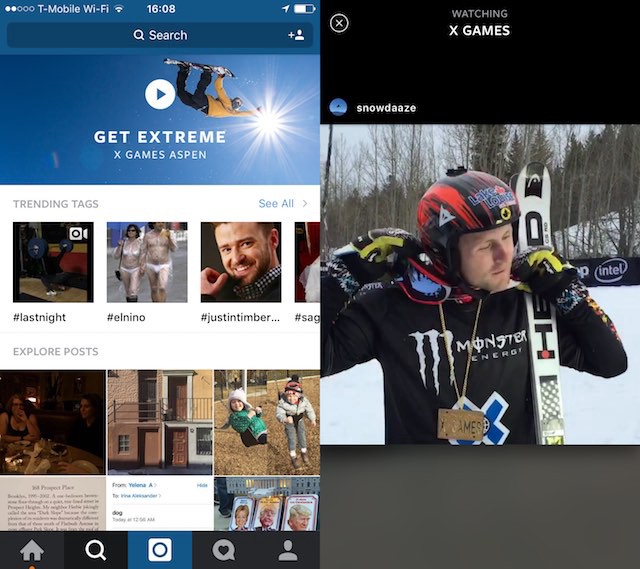
Here are some screenshots of Snapchat’s coverage of the X Games in Aspen:
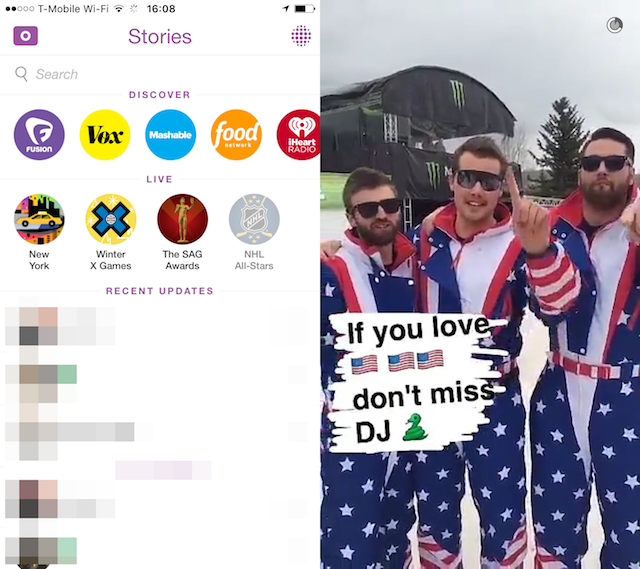
Here are some screenshots of Twitter’s coverage of the X Games in Aspen:
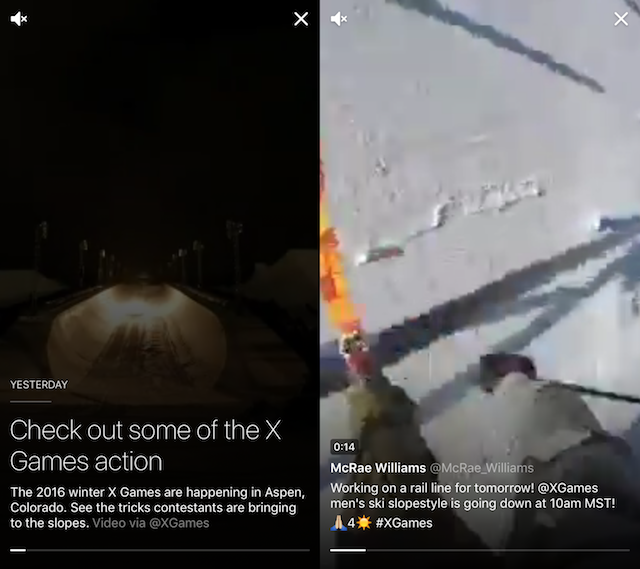
This is not three platforms linking out to stories of videos about the X Games, or three platforms offering commentary around a TV event. This is three platforms showing off what’s theirs: the things people are compelled, for one reason or another, to share. These overlapping stories will happen more and more often. And they’re instructive… somehow? Probably? Twitter’s feels sort of thin; Instagram’s feels better, but sort of boring; Snapchat’s feels most intimate. All are incoherent — the X Games, which spreads moderately famous people across numerous events, might not be the best demonstration of a platform’s muscle.
These types of stories, which are arranged and published by the platforms themselves (except in cases where Twitter lets a limited number of partners make Moments), serve mostly to show off what’s there to start — they’re showcases of what each platform’s users are already supplying with no extraordinary incentives. They emphasize each platform’s strengths: Instagram’s ubiquity among public figures; Twitter’s utility for straightforward deliberate communication; Snapchat’s immediacy and raw aesthetic. They also hint at what’s left for potential partners to figure out: Twitter doesn’t feel like it takes you behind the scenes; Instagram feels extremely guarded and deliberate; Snapchat excels at creating the feeling of presence but its use as a storytelling tool is not very well developed or understood.
For the self-sustaining platform, these translate as a series of questions. What aren’t we getting already, and what do we need? What goes pro, what doesn’t? How do we pay, if we do? What kind of marketplace do we set up; how much do we participate in it?
So far, we have a few early answers. Facebook lets anyone post text, photos or videos. It lets some others post articles, which can contain ads. As for who gets to make money from videos, which it says will soon make up a majority of visible content on the site, that’s still up in the air. If it’s anything like Instant Articles — a much smaller project that might not tell us much, honestly, about the direction of a much more important product — then the partnerships might be limited. If it’s a big open marketplace with generous revenue sharing, like YouTube, then it could develop into a media culture unto itself, as YouTube did. (Recall, also, that YouTube invited a large slate of premium partners — incentivized with multi-million dollar contracts — to make shows in 2011. Not entirely unlike the first round of Discover participants! How many of those worked out?)
Twitter lets anyone post text, photos or videos; how partners are supposed to make money after longer tweets or the expansion of Moments into a content type available to more partners is, perhaps, not question Twitter is worried about at this point. That’s not to say Moments isn’t conceptually interesting! It can really work, in its weird way.
This emergent genre of ⚡ moment is lovely, & it just might be how stories are ~supposed~ to be told on phone screens https://t.co/IE3Aff0lgf
— Robin Sloan (@robinsloan) January 14, 2016
(Twitter also just introduced a way to view entire conversation threads in a pop-up. Which, if you were to, say, thread 20 tweets together into a single story, are a little bit like DIY Moments. With plenty of space for ads!)
Snapchat lets anyone post limited text, photos and videos, and lets partners post more text, images and videos in a place everyone can — is persuaded — to see. Instagram lets people post photos, videos and text, and curates stories itself. But, for now, it courts partners with promises of audience and reach, not money. It’s taking that part slowly; it’s possible that it doesn’t need to bother with it at all.

At core, each social platform can be described as the same type of business: a multi-sided marketplace between advertisers and users. Andrei Hagiu, who has published extensively on the economics of multi-sided platforms, characterized them as such in 2013:
On multi-sided platforms like Facebook — and Amazon, Apple, Google, Twitter, etc. — value is created through the interactions between affiliated users, developers, and advertisers.
Facebook and these other companies want to control API access and critical user information because it’s that data which unlocks monetization opportunities.
To the extent that the major platforms make money, they mostly do it through selling ads against their users. They have gathered large networks of people, who are present largely for each other. Access to those users is valuable to people who want to sell them things, and the platform controls that access. If the business model remains more or less this, the value of an outside media company is limited to its ability to improve one of a small set of circumstances for the platform. If its participation gets more people to use the platform, that’s great. If its participation creates more of whatever specific thing it is the platform’s ad products depend on — views, time engaged — that’s great too. There are other reasons for platforms to court partners like.. idk. Completeness? Seeming Very Premium. Not Knowing Who To Invite So Inviting The People And Companies You Know Already! But none are as clear as helping the platform make money or inflate metrics in a measurable way. The biggest YouTubers, for example, serve this function, and are paid approximately half of the revenue Google collects from their work.
Facebook’s first revenue sharing product for video wasn’t a traditional form of video ad, but ads buried in recommended videos placed near videos. It was an incremental experiment. A few months after that, on an earnings call, Zuckerberg said, “there’s a certain class of content which is only going to come onto Facebook if there’s a good way to compensate content owners for that.” This suggests ad products catered, perhaps, to longer videos; one could make the argument that shorter videos, which are meant to be viewed within the regular News Feed, are already as monetized as they need to be, from Facebook’s point of view — they’re already sandwiched between ads. Does this “certain class” look like YouTube’s vast band of gradually professionalizing amateurs? Or does it look more like the TV-quality shows and films that are now inspiring bidding wars between Netflix, Hulu, HBO and Amazon? Facebook’s default answer seems to be “all of the above.”

Understood from perspective of the web, the last five years have represented a sort of tragedy of the commons. The platforms grew big and strong. Websites and publishers catered to the needs of those platforms, vague worries about control and identity set aside for the necessary pursuit of audience in an unpredictable environment. Nobody did anything wrong, exactly, and it’s not clear what they should have done differently. Some publications that functioned well under the referral regime will struggle under platforms. Others might succeed, more might materialize out of the Venture Ether. Yet others will chase new things, and many more will just continue to try everything.
Google’s Accelerated Mobile Pages are described by the company as a way to repair an ailing “open mobile web,” and have a few people convinced they can turn back the tide — or, at least, preclude some new proprietary formats, preserving a standards-guided shared resource, albeit under the guidance of Google. They load fast, and their ads are unobtrusive. And here’s how they show up in Search:
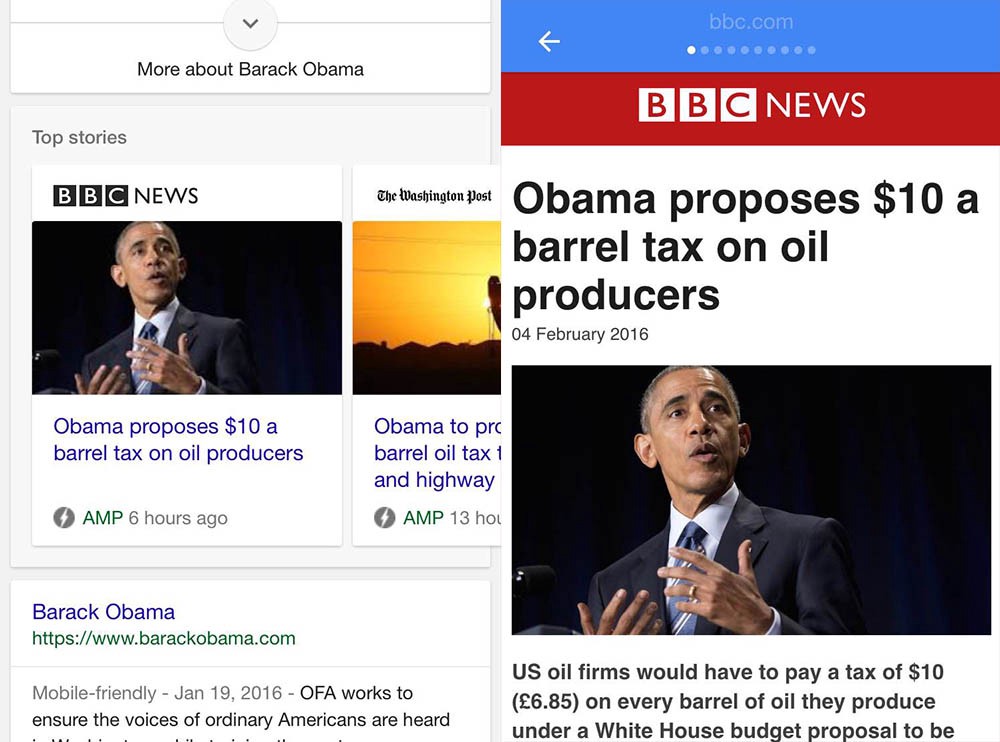
An AMP search shows you: The Google header, some informational card generated by Google, then a carousel of AMP pages. All that I’ve checked, presumably due to the limits imposed by AMP, have no page navigation to other parts of the publisher’s site. A few contained related links deep in a footer. This is an obviously faster experience for Google searchers. It also has the effect of making the result links below the AMP links seem either second rate or, perhaps, like an archive. AMP is, especially on phones, a refuge for a platform-adjacent web. But even Google’s best attempt at salvaging the consumer web involves dead-ending sites. It’s as clear a sign as any that any promising future for the web involves something like starting over. And why can’t it? The platforms are powerful relative to what came before them. But most of them aren’t truly ubiquitous, especially outside of the United States. There are a lot of internets already, and plenty yet to come.
Facebook, for example, isn’t without a context of its own. It may have a billion and a half users, but 80% of the money it makes from them comes through mobile platforms owned by Google and Apple (which serve data through telecoms). There is an appealingly neat future narrative in which Apple and Google reverse-engineer the feeds and messages of all the apps their platforms support through their respective notification trays, lock screens and wristwatches. And it’s fun to think about: What if notifications became themselves, I don’t know, sharable objects? Links in the Facebook News Feed gradually accumulated mass until they became post unto themselves; a notification in Android, the thinking goes, could absorb most, or all, of the utility contained in the app it’s supposed to link you to. And… sure? Apple and Google have not had much luck with major social platforms but maybe their leverage in this situation is real. They could try to use it.
I think subtler means of control are more important here. Have you noticed more links from social feeds leading you directly to apps? Follow a link from Twitter and it will open your New York Times app; open a Medium post from a feed and, if you downloaded the app, you’ll bypass the website. Tap an ad on Instagram and it might take you directly to the App Store. The middle ground between services now isn’t the web and its standardized links, it’s Android and iOS and their own internal deep-linking standards. It just recently became possible, for example, to travel directly into a Snapchat channel from Twitter and Facebook.
But this type of relationship requires cooperation, too. Open an Instagram link in the Twitter app, and it opens the mobile site. Only after you tap again, on “Open in app,” do you switch over. This is exactly the kind of codependency that the platforms are consciously moving away from, so I’d hesitate to assume that’s where things are headed. I don’t expect to see Twitter Moments embedded in the News Feed, or Snapchat Discover stories reproduced in WhatsApp. The way these links are deployed and denied, at least, is worth watching. As is any vigilance about unauthorized reposting, which — search YouTube for [INTERNET CELEBRITY NAME] and SNAPCHAT or VINE and see what comes up — is having quite the moment. Here’s an Instagram account called “Kylie Jenner Snapchats” with over 350,000 followers; here’s a 25-minute compilation of 6-second Vines from Brittany Furlan hosted on YouTube. 7.4 million views.
Anyway: The types of collaborations that currently function best on platforms are not really collaborations at all. Twitter Moments look great linked in a Twitter feed, and Vines embed nicely, and Periscope streams (strikingly!) play in the feed, but Twitter owns Vine and Periscope. Discover stories share seamlessly in Snapchat’s chat function, because why wouldn’t they?

And so we arrive back at [SPINS WHEEL] Facebook? Again? [SPINS REVOLVER CYLINDER] Haha, hm. Well, ok: You know where Instagram posts look just fine? In the Facebook News Feed, where they are expanded to full size. Facebook videos share pretty nicely to Facebook Messenger. Facebook tested a “share to WhatsApp” button in the Facebook app a couple months ago. To a messaging app, Facebook is the outside world. One layer up, Facebook is experimenting with its own notifications system. One further, the company is running tests to see how it would manage if its apps got removed from Google’s Android Store. A layer above that, the company is partnering with mobile carriers in developing countries to provide free access to Facebook. A layer above that, Facebook is developing the technology to — again, at first, in the developing world — to become an ISP. Sheryl Sandberg, Facebook’s COO, used a familiar-sounding phrase on the company’s first earnings call of 2016: Facebook, she said, was the new “town hall.”
Twitter’s Vine-Periscope-Twitter stack is comparatively short and narrow. I’m not sure quite what’s left if Twitter, still the most porous service, withdraws further from the web. It’s anyone’s guess whether Snapchat can build Discover into a serious set of channels and publishers, or into a market-like platform that would give its users a glut of media to snap about. But a Facebook News Feed that produces articles and videos and photos exists within a larger ecosystem that its parent company owns. The theoretical Discover-post sharer is, simultaneously, a Snapchat user, a Snapchat Discover reader, and a Snapchat text chatter. The Facebook sharer is just a Facebook user. Maybe a Messenger user. Or maybe uses WhatsApp, which, it so happens, has aspirations on the platform level and well beyond (2016 will be a year in which lots of app humans repeat the phrase “conversational media”).
As a service, Facebook proper might strain to do and be everything. It might not convince Kanye, or Khaled. But maybe it doesn’t need to. That’s what vertical integration is for.
Gifs cut from this video courtesy of Okayama University and the Tokyo Institute of Technology. NO COPYRIGHT INTENDED!!!!
